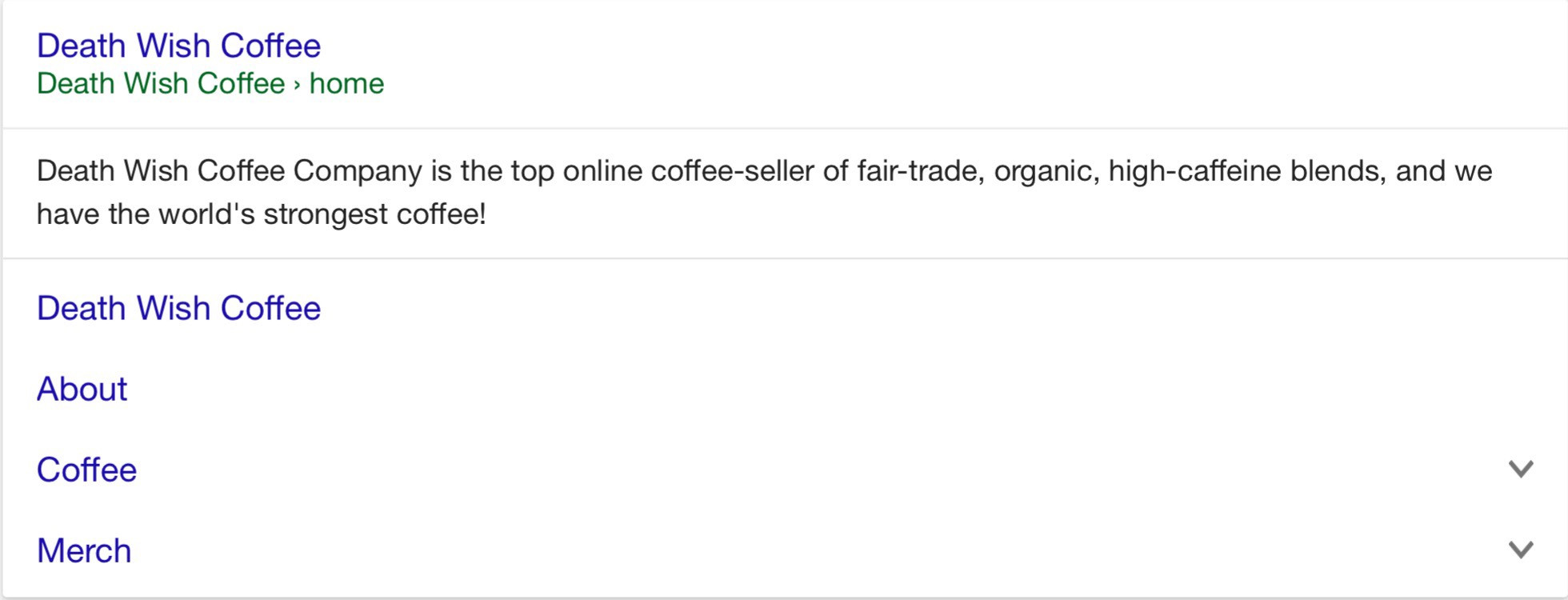You’re writing your product descriptions, optimising your images, and mastering most of the other elements of awesome ecommerce SEO.
Still, if you’re like many business owners, one aspect of SEO could be giving you trouble: meta descriptions.
Defining the Meta Description
For those who aren’t familiar with meta descriptions, here’s a quick recap.
When you type a search query into Google, let’s use “temporary tattoos” as an example, you’re led to a SERP (search engine results page). This page is extremely complicated, but for now let’s ignore all the ads, images, and videos, in favor of the more traditional “organic” results.

The blue words at the top are the “Title Tag.” They’re the title of the web page. Below them you’ll see a description of no more than 160 characters. This is the meta description.
Dissecting a Home Page Meta Description
Reading other people’s meta descriptions will make the process look deceptively simple, but that simplicity is the very thing that makes them so hard to write. The 160-character limit means the meta description can’t be much longer than a tweet.
The good descriptions give you a brief overview of what the site is about, as well as a compelling reason to click the title tag. It all happens so quickly and painlessly, many searchers won’t even notice themselves making a decision. They’ll simply click on the link, satisfying their curiosity without having to think about it.
Here’s a good example of a meta description:

All together, it’s just twenty one words. Clever naming helps Death Wish Coffee pack a punch here. With the first three words, “Death Wish Coffee,” you already get an idea of what the company sells (coffee) and what defines its brand (hardcore, but tongue-in-cheek about it).
Death Wish then says it’s the “top online coffee-seller.” With these words, it positions itself as the best, lets the reader know it’s an ecommerce store, and reaffirms that it sells coffee.
The next few words back up Death Wish’s claim that it’s the best. After all, it’s an ethical company (“fair-trade”) that uses the best (“organic”) ingredients, all while making sure the customer gets the strong cup of coffee they want (“high-caffeine”).
Even the word “blends” positions them as coffee experts, the sort of people who put care into making sure their product is the best.
The second half of the meta description repeats the core concept of Death Wish’s brand in a way that resonates, saying, “… we have the world’s strongest coffee!”
Counting it all up, we have four words that are variations on the word ‘coffee’, two claims that it’s the best at what it does, and three different ways of backing up that claim.
All in this one sentence: “Death Wish Coffee Company is the top online coffee-seller of fair-trade, organic, high-caffeine blends, and we have the world’s strongest coffee!”
Now that’s good copywriting.
Dissecting a Product Page Meta Description
Writing meta descriptions for your product pages is a little easier than writing them for your home page, because your product pages aren’t supposed to speak for your business as a whole.
Instead they’re speaking for something that offers a tangible benefit to shoppers.
Selling spatulas? Let the reader know that this spatula will make cooking so much easier.
Selling lawnmowers? Have the reader imagine a fast and easy journey through the grass.
For a good example, let’s check out a meta description for So Worth Loving’s stickers:

Immediately and in all-caps, the description makes you realise that a lot of stickers don’t last as long as you want them to. Then, SWL promises that their stickers solve that problem.
Capitalising the meta description is a bold move, and I certainly wouldn’t recommend capitalising the whole thing. But here it works, because the capitalisation doesn’t seem like it’s there just to grab attention. It also does the work of separating the note from the rest of the text.
After the note, this description works well because it keeps the focus on the reader.
You do need to give some idea of what differentiates the product—So Worth Loving does this by emphasising the durability and by letting its site name suggest that the sticker is going to be really, really cool—but after that it’s all about letting the customer visualise themselves with the product.
The description suggests the joy a buyer might get when they see the sticker as a “best little reminder,” offering various ways the sticker could easily fit into their life: “Stick them on your car, laptop, water bottle, wherever you want to see them.”
The ending in particular works beautifully. It starts the sentence by suggesting the product will make you feel some powerful emotion, but then it makes you click the title tag to find out what that emotion actually is.
Though some SEO experts will tell you to make sure your meta descriptions all finish with complete sentences, the half-sentence can do wonders for your clickthrough rate.
If you’re going to use this strategy, it’s good to get your meta description as close to the 160-character limit as possible. To check and see how it will look on Google, you can use this tool.
How to Write a Meta Description
Now that we have an understanding of meta descriptions, you’re probably wondering: what are the best ways to apply this knowledge to your business?
First, focus on what would compel a searcher to click on your title tag.
That requires answering two questions:
- What are you offering?
- Why should I buy from you?
For product pages, the first query has a simple response: you’re offering your product. The second will be resolved by the simple fact that you’re the one selling the product!
Meta descriptions for your home page are a little trickier.
As we saw in the Death Wish Coffee example, the best thing is to repeatedly emphasise your brand. That’s the one thing your whole store offers, and it’s the reason they should buy from you.
Let readers know what you do, tell them about your unique selling proposition, and convey this information multiple times, because the meta description isn’t a place for subtlety.
Struggling to come up with an effective meta description for your home page is common, so it’s best to be patient and think hard about your brand.
If you’ve been around for awhile, what do returning customers say about your business? And if you’re new, what made you think this business would get customers?
Talk to people about your business, formulate the description like you would an elevator pitch. You’ll probably want to go through a couple drafts. It’s important to get things right, because this will be the first exposure many customers have to you and your brand.
When to Write a Meta Description
Believe it or not, this article isn’t going to claim you should hurry and make sure all of your pages have meta descriptions.
For one thing, Google automatically creates these descriptions by pulling from the content of your page, and that process lends more flexibility than a copywriter can manage.
Optimising a page for one keyword is hard. (But worth it!) When people land on a page via a variety of search terms, it becomes too difficult to SEO properly.
Also, for businesses with hundreds (if not thousands) of pages, going back and writing meta descriptions for every single one would be a Herculean task.
Instead, it’s best to focus on the pages that get the most traffic from search engines. Take your top ten or twenty pages and think, “Are we really selling the product here, or is there a way we can improve the click-through rate?”
Moving forward, whenever you or a writer you’ve hired puts together a new page of content, it’s a good idea to have them write a meta description in the resource’s details page of the Shopify admin.
Not only will this improve your SEO. It will also force you to condense the idea of the page into just a few words.
This becomes the “topic sentence” for the page, essentially, and it helps you determine whether the page’s copy continually fulfills the promise of the meta description.
Meta Descriptions Are Your Best Salesmen
Ultimately, the meta description is a promise you make to searchers. Among a sea of competing web pages, it calls out to them and says, “This is the page you’re looking for.”
When writing your meta descriptions, make sure to remember the three key things we talked about in this article:
1. Your Description Can’t Be More Than 160 Characters
It’s okay to write a meta description that cuts off halfway through the sentence. Just make sure you know you’re doing it.
2. Focus on the Customer
The descriptions for your product pages should focus on how much better this product could make the customer’s life. The home page description should sell the way your brand matches the customer’s wants/needs.
3. Repeat, Repeat, Repeat
You don’t have much time to make an impression. Once you’ve found the message you’d like to convey, make sure every phrase and word choice conveys the message.
Hopefully, this article has helped you understand the art of writing meta descriptions. Once you’ve applied these tips to your own websites, you can say goodbye to low click-through rates.



